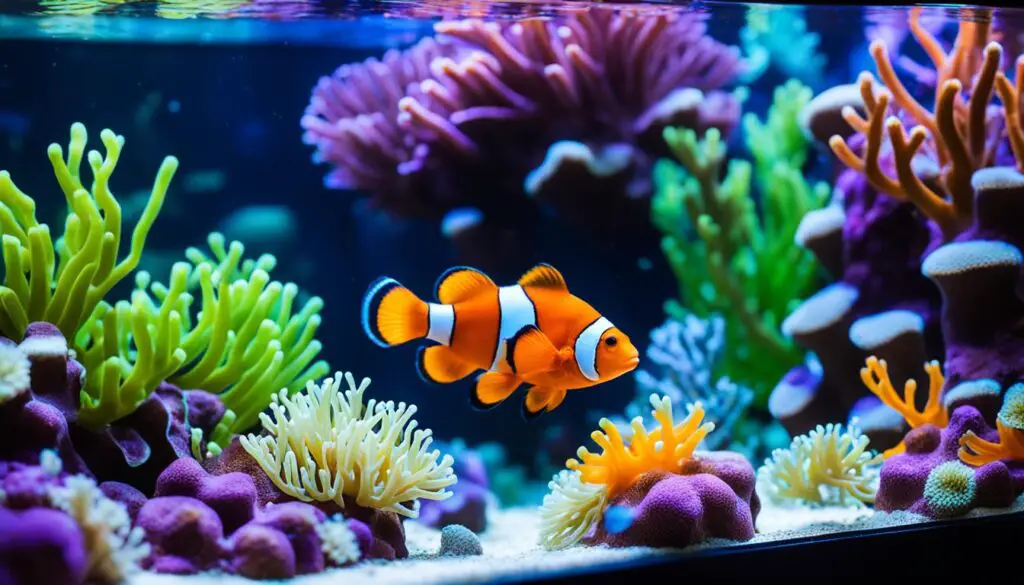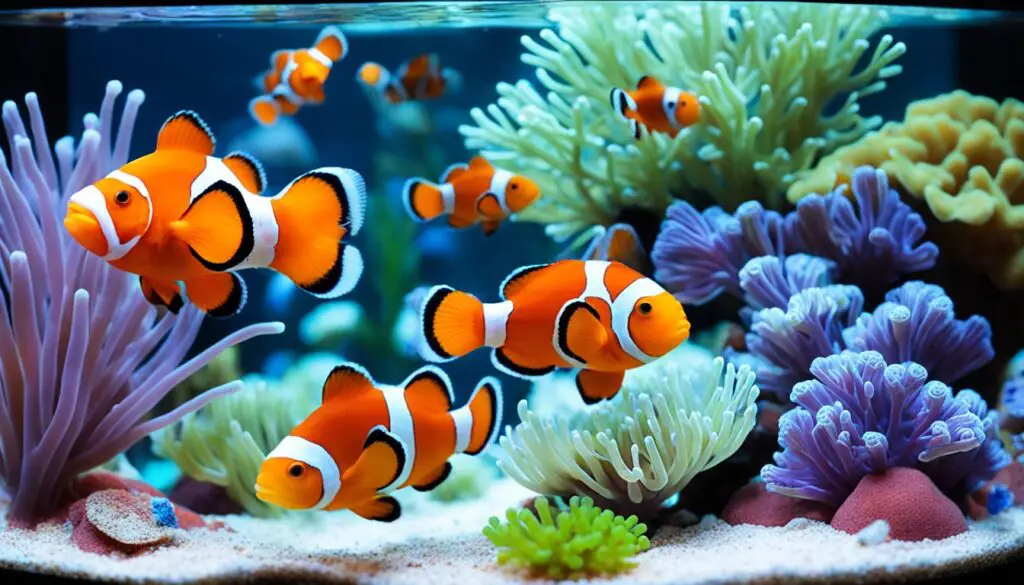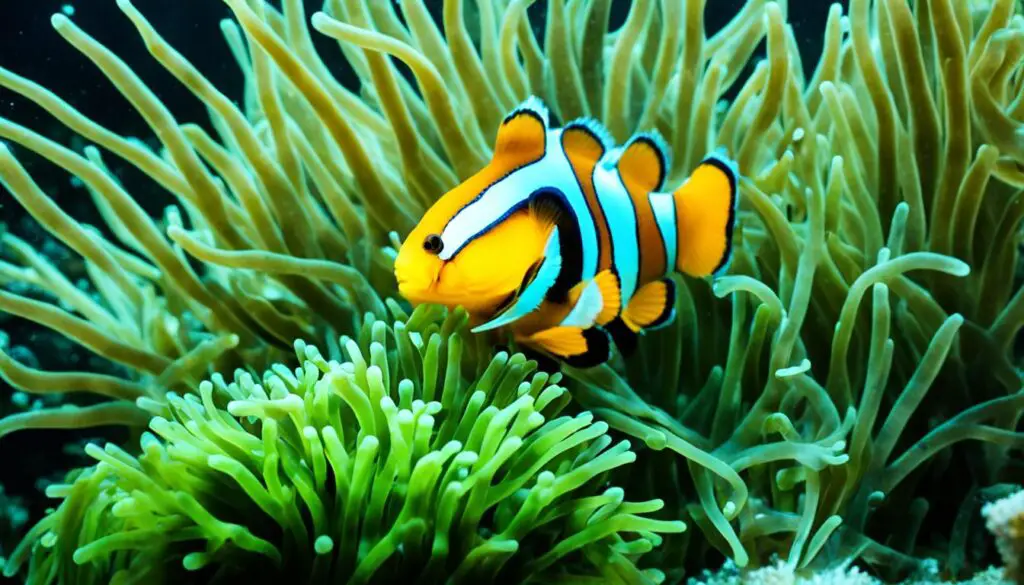How To Breathe When Snorkeling
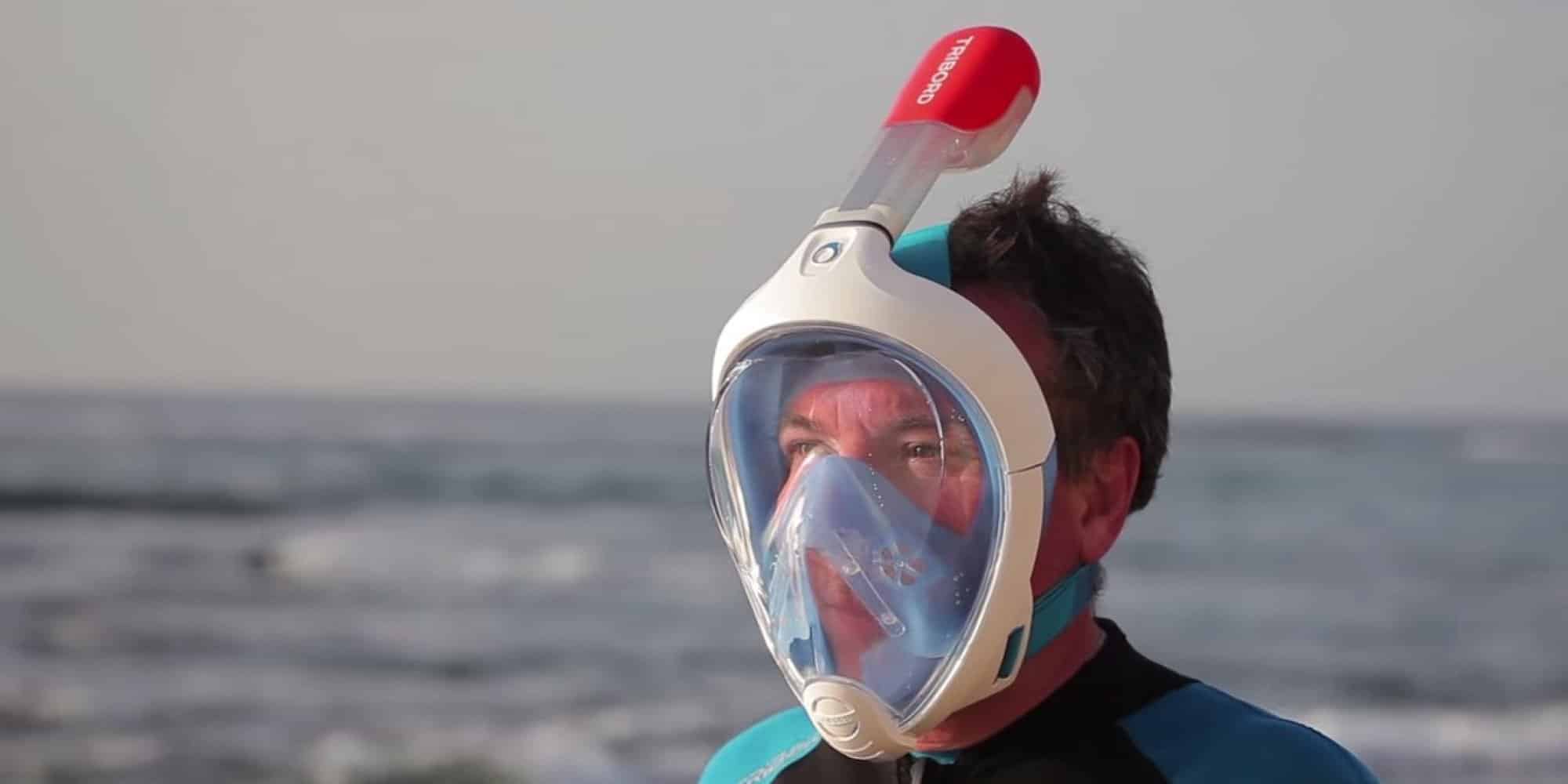
Introduction
How To Breathe When Snorkeling: Snorkeling is a captivating and accessible way to explore the wonders of the underwater world. Whether you’re gliding over vibrant coral reefs, observing colorful marine life, or simply enjoying the serenity of the ocean’s depths, mastering the art of breathing while snorkeling is essential for a safe and enjoyable experience.
Breathing underwater might initially seem daunting, but with the right techniques, it can become second nature. In this guide, we’ll delve into the fundamental principles of how to breathe when snorkeling, equipping you with the knowledge and confidence to embark on underwater adventures like a pro.
Proper snorkeling breathing techniques not only enhance your comfort but also extend your underwater exploration time. By efficiently managing your breath, you’ll reduce the risk of fatigue and anxiety, allowing you to savor every moment beneath the surface.
We’ll explore topics such as breath control, relaxed inhaling and exhaling, and the importance of using snorkels and masks effectively. You’ll also gain insights into overcoming common challenges like water entering your snorkel or dealing with unexpected currents.
So, whether you’re a novice eager to take your first breaths underwater or a seasoned snorkeler looking to refine your skills, this guide will provide you with the knowledge and confidence to make your next snorkeling adventure truly unforgettable.
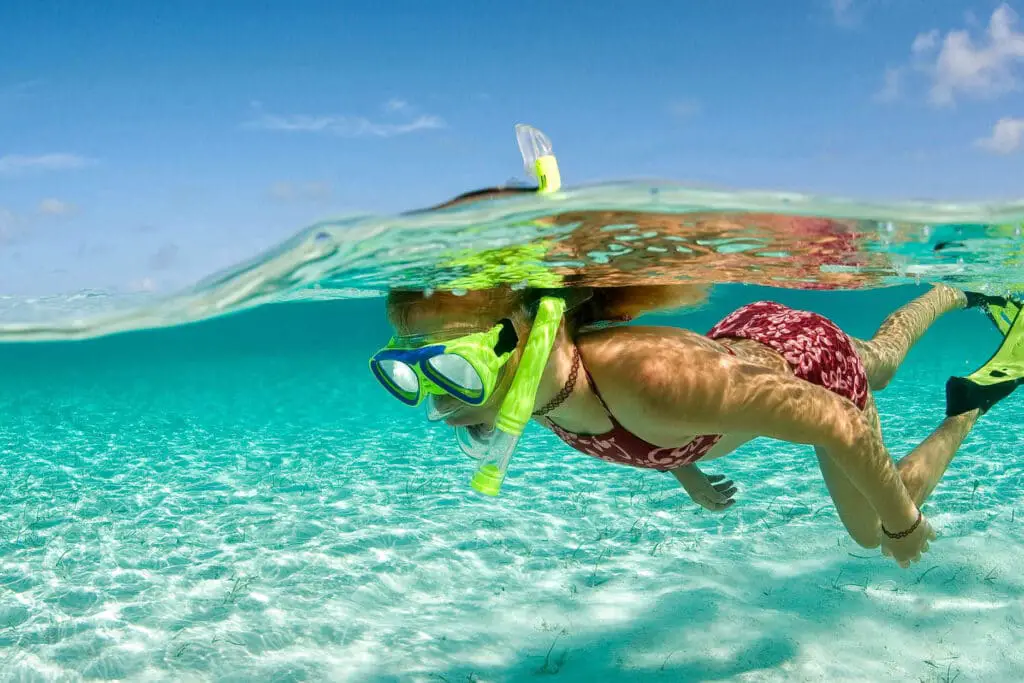
Can I breathe underwater with a snorkel?
Unlike scuba diving where you have your own air supply, snorkels don’t let you breathe while you are fully submerged in the water.
Using a snorkel, you can’t truly breathe underwater like a fish, but you can breathe while floating face down on the water’s surface. A snorkel is a simple, yet ingenious, device that allows you to draw in air from above the water without lifting your head. It typically consists of a curved tube with a mouthpiece and a snorkel mask that covers your eyes and nose.
When you’re snorkeling, you can submerge your face in the water and breathe through the snorkel. This enables you to observe underwater life, explore coral reefs, or enjoy the serenity of the ocean’s depths while maintaining a consistent supply of air. The snorkel’s design ensures that water does not enter the tube, thanks to a valve or a splash guard at the top.
However, it’s essential to keep the snorkel’s open end above the water at all times to breathe comfortably. If the snorkel dips beneath the surface, water may enter, causing you to inhale water instead of air. With proper technique and the right equipment, snorkeling becomes a delightful way to experience the underwater world while staying connected to the world above the waves.
Why can’t I breathe through my snorkel?
1. Increased dead space: With a snorkel, you have about twice the dead space, or stagnant air that goes into your lungs and out to the snorkel, but doesn’t make it all the way out, so it stays in the snorkel and gets sucked in again next time you inhale (think of how electricity moves in AC current).
If you find that you can’t breathe through your snorkel while snorkeling, several factors may be causing this issue:
- Water Entry: The most common reason is that water has entered the snorkel. This can happen if you submerge the snorkel’s open end or if waves splash over it. To avoid this, make sure to keep the snorkel’s top end above the water’s surface at all times.
- Improper Fit: A poorly fitting snorkel mask or mouthpiece can lead to air leaks, making it difficult to breathe comfortably. Ensure that your mask creates a watertight seal around your face, and the mouthpiece fits securely and comfortably in your mouth.
- Obstruction: Debris or sand may block the snorkel’s airway, restricting airflow. Regularly check and clear the snorkel for any obstructions before and during your snorkeling session.
- Inexperienced Breathing: If you’re new to snorkeling, it may take some practice to master the art of relaxed, rhythmic breathing through the snorkel. Focus on slow, steady breaths and avoid rapid or shallow breathing.
- Snorkel Design: Some snorkels are designed with features like dry valves or purge valves to prevent water entry and make breathing easier. Using a snorkel with these features can improve your overall experience.
By addressing these potential issues and practicing proper snorkeling techniques, you can ensure that you can breathe smoothly and enjoy your underwater adventures without interruptions. Always remember to prioritize safety, stay calm, and make adjustments as needed to maintain clear airflow through your snorkel.
How do you snorkel without swallowing water?
To avoid swallowing water when snorkeling, make sure your equipment fits you correctly. Control your breathing, use your tongue as a splash guard when you inhale, and exhale sharply when needed to blow any water out of the tube. Be sure to relax and practice in calm, shallow water before heading out into deeper areas.
Snorkeling is a delightful way to explore the underwater world, but it can be frustrating when you accidentally swallow seawater. To enjoy a seamless snorkeling experience without ingesting water, a few key techniques and precautions can make all the difference.
First and foremost, ensure your snorkel equipment fits properly. A well-fitted mask should create a tight seal around your face, preventing water from entering. Adjust the straps and perform a quick “sniff test” before diving in to confirm the seal’s integrity.
Additionally, master the art of controlled breathing. A snorkel tube has a top valve that should remain above the water surface at all times. To breathe efficiently, take slow, steady breaths and avoid rapid or deep inhales, which can lead to water intake.
Practice maintaining a horizontal position in the water, keeping your body as parallel to the surface as possible. This minimizes the chances of waves splashing into your snorkel.
Stay aware of your surroundings and the water conditions. Strong currents or choppy waters can increase the risk of water entering your snorkel. Always stay vigilant, and if water does enter your snorkel, a simple exhalation will clear it.
By mastering these techniques and choosing the right equipment, you can enjoy the mesmerizing world beneath the waves without the unpleasant taste of seawater.
Can you breathe through a snorkel when you are 7 feet underwater?
Even just a few feet beneath the surface, the pressure is great enough that we can’t expand our lungs against the water pressure to inhale a breath of air from the surface.
Snorkels are designed for surface use, allowing you to breathe while your face is submerged just below the water’s surface. They rely on the natural air pocket created in the snorkel tube to provide you with the necessary oxygen.
When you dive deeper than a few feet, the pressure increases, compressing the air pocket inside the snorkel tube. This compression makes it impossible to draw in fresh air. Attempting to breathe through a snorkel at 7 feet underwater would result in inhaling water, which can be dangerous and potentially life-threatening.
For depths beyond what a snorkel can handle, you would need to transition to scuba diving equipment, which includes a tank of compressed air, a regulator, and other gear designed to provide you with a continuous and controlled supply of breathing gas at different depths.
While a snorkel is a fantastic tool for observing the underwater world near the surface, it is not suitable for depths of 7 feet or more. For deeper underwater exploration, proper scuba diving equipment and training are essential to ensure your safety and the ability to breathe comfortably beneath the surface.
Do you get oxygen when snorkeling?
The actual act of snorkeling is when a person uses equipment like a snorkel tube to breathe near the surface of the water while their face is submerged wearing a glass lens mask to see underwater. You do not need oxygen tanks or any expensive equipment to enjoy snorkeling.
When snorkeling, you don’t receive a direct supply of oxygen like you would with scuba diving equipment, such as tanks and regulators. Instead, snorkeling relies on a simple system that allows you to breathe surface air while keeping your face submerged in the water.
A snorkel is a tube typically made of plastic or rubber that extends above the water’s surface while you swim face down. It allows you to inhale and exhale air from the atmosphere. When you breathe in through the snorkel, you’re drawing in oxygen-rich air from the environment above the water. When you exhale, the used air is expelled into the water through a one-way valve or purge valve, preventing it from re-entering the snorkel.
This ingenious design lets you stay submerged comfortably, exploring the underwater world while continuously receiving fresh air from the surface. It’s essential to ensure the snorkel’s top remains above the water to access this oxygen supply. If water enters the snorkel, you may need to clear it by exhaling forcefully.
While snorkeling, you do get oxygen, but it’s drawn from the surrounding atmosphere, not from a tank or other artificial source like in scuba diving. This makes snorkeling a simple and accessible way to experience underwater wonders without the complexities of scuba equipment.
Can I breathe through my nose while snorkeling?
It is possible to breathe through your nose while snorkeling, but it requires specific equipment and techniques. Traditional snorkels have a mouthpiece designed for inhaling and exhaling through the mouth, allowing you to keep your face submerged while breathing.
However, there are specialized snorkels called full-face masks that cover both your nose and mouth, allowing for natural breathing through either. These masks provide a more comfortable and natural experience, especially for beginners or those who may feel uncomfortable breathing solely through their mouths.
Using your nose to breathe while snorkeling can have advantages. It allows for a more relaxed and natural breathing pattern, reducing the potential for hyperventilation or discomfort.
Additionally, nasal breathing can help regulate pressure, which can be particularly beneficial when diving to different depths. It’s important to note that while breathing through your nose is possible, it’s essential to remain aware of your breathing and not to push your limits. Regular practice and familiarity with your equipment are crucial for a safe and enjoyable snorkeling experience.
How should I position my body while snorkeling to breathe effectively?
When snorkeling, proper body positioning is crucial for efficient and comfortable breathing. To breathe effectively while snorkeling.
- Horizontal Alignment: Keep your body as horizontal as possible in the water. This means lying face-down with your legs extended behind you. This position reduces drag and helps conserve energy, allowing you to snorkel for longer periods without fatigue.
- Float at the Surface: Try to stay close to the water’s surface. This minimizes the distance your snorkel needs to reach above the water, making it easier to breathe. A snorkel with a splash guard on top can help prevent water from entering when a wave passes over.
- Relaxed Body: Keep your body relaxed, especially your neck and facial muscles. Tensing up can lead to discomfort and a less effective seal around your snorkel mask.
- Slow and Deep Breaths: Take slow, deep breaths through your mouth. Breathing through your nose can lead to fogging of the mask. Exhale fully to ensure you expel all used air from the snorkel before inhaling again.
- Practice Controlled Buoyancy: If you can, practice controlled buoyancy to maintain your position effortlessly. Use your fins and slight adjustments in body positioning to stay afloat with minimal effort.
Can I dive underwater with a snorkel in my mouth?
Diving underwater with a snorkel in your mouth is a common and enjoyable activity for anyone looking to explore the underwater world without the need for scuba gear. A snorkel is a simple tube that allows you to breathe while floating face down on the water’s surface. It typically consists of a mouthpiece, a breathing tube, and a snorkel mask that covers your eyes and nose.
With a snorkel in your mouth, you can submerge your face into the water and breathe through the tube, allowing you to observe marine life, coral reefs, and underwater landscapes. It’s a fantastic way to connect with nature and experience the beauty of the ocean.
However, it’s important to remember that snorkeling is limited to relatively shallow depths, usually no more than 1-2 meters (3-6 feet) below the surface. Beyond this depth, the snorkel won’t provide enough air, and you risk inhaling water. For deeper exploration, scuba diving equipment is necessary.
Snorkeling with a snorkel in your mouth is a wonderful way to enjoy the underwater world safely in shallower waters, providing an up-close encounter with marine life and stunning underwater scenery.
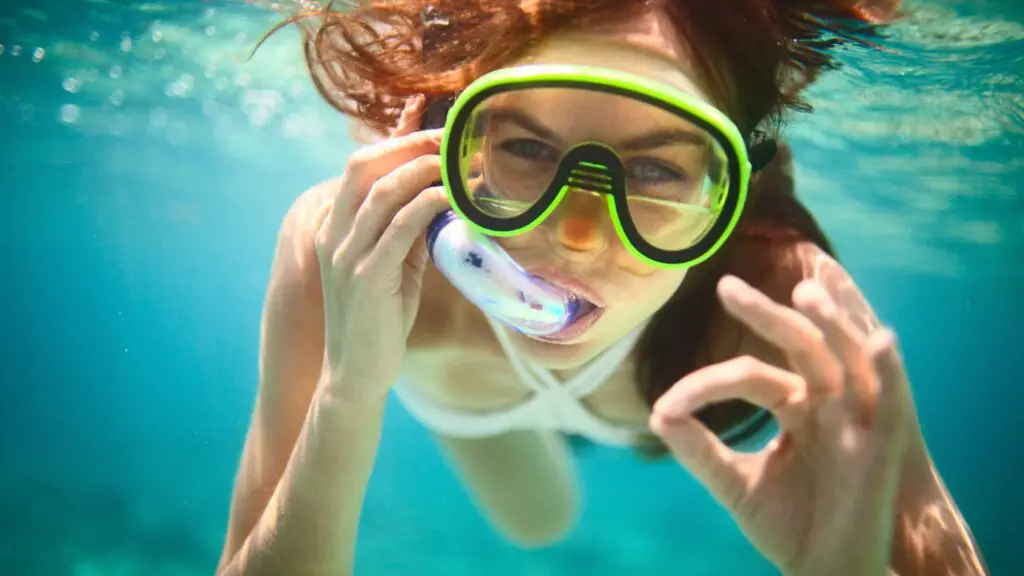
Conclusion
Mastering the art of breathing when snorkeling is a vital skill that can elevate your underwater experiences. Through this guide, we’ve explored the essential techniques that enable you to breathe effortlessly while exploring the mesmerizing marine world.
By understanding the importance of relaxed, rhythmic breathing, breath control, and the proper use of snorkels and masks, you can enhance your comfort and extend your time beneath the waves. These skills not only reduce anxiety and fatigue but also foster a deeper connection with the underwater environment.
Remember that practice is key to becoming proficient in snorkeling breathing techniques. Regularly honing your skills in controlled environments will boost your confidence and ensure you’re well-prepared for any snorkeling adventure.
Safety should always be a priority. Always snorkel with a buddy, stay aware of your surroundings, and respect marine life and the fragile ecosystems you encounter.
So, go ahead, take a deep breath, and immerse yourself in the captivating world that lies beneath the surface of the ocean. By mastering the art of breathing when snorkeling, you’ll unlock a realm of beauty, tranquility, and wonder that will stay with you for a lifetime.

